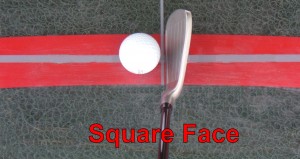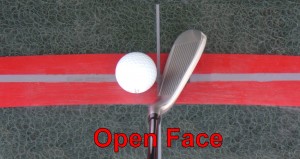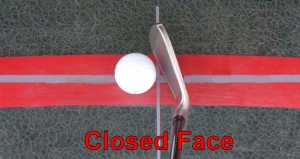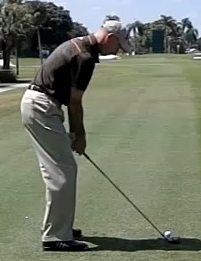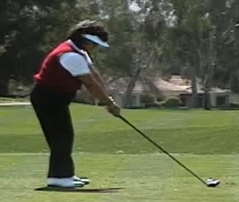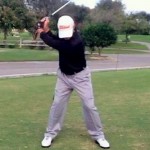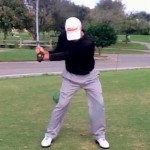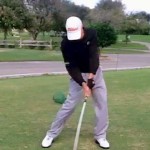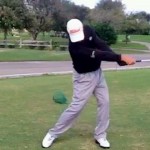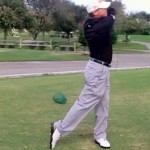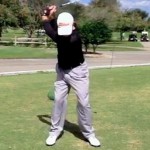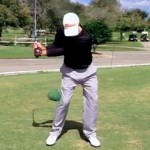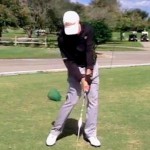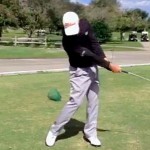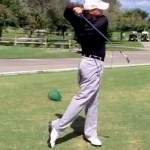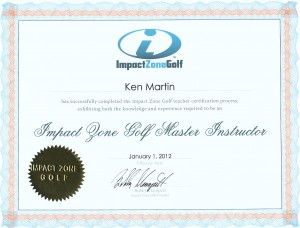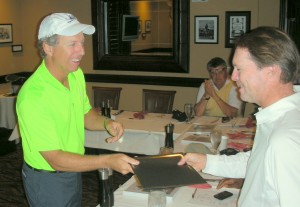- As discussed in my previous article Know What before Know How, knowledge is the foundation of my teaching philosophy. Knowledge about the primary concepts of what makes a ball fly and what the club has to do to accomplish ball flight.
Once the ball is airborne, it will either fly straight, curve to the right or curve to the left. Now, you are probably aware of what causes these variations in flight, but it bears reviewing because, as you will read later, clubface awareness will help you create the shots you want when you want them.
The three pictures below tell the story about varying ball flights.
The Ball Flight Laws, (first presented by Dr. Gary Wiren, PGA), tell us the following (for right-handed golfers):
- Square Clubface to the Swing Path = Ball Flies Straight in direction of Path
- Open Clubface to the Swing Path = Ball Flies Right of Path
- Closed Clubface to the Swing Path = Ball Flies Left of Path
Simple, right? The basic concepts to create a ball’s flight and control it’s direction are clear. Strike the ball below the equator and it will fly; control the clubface orientation relative to the clubhead’s path at impact and you will control the ball’s direction. Now that’s some knowledge you can use!
It’s a fact that the golf ball reacts to only one thing at the moment of impact and that is the clubface. It follows that if you focus your attention on the clubface during impact you will have the best chance of controlling where the ball goes. And along the way, intention on the clubface during impact will become the foundation for the swing you build.
Follow my logic thread below and I believe it will help you embark on playing the best golf of your life!
It all starts with an image of what you want the ball to do to get to the target. Generally, the  term for this image is Ball Flight, even though the chosen shot may be one that rolls the whole way, as in putting. Once you’ve selected the Ball Flight, you then choose the club that will best accomplish it. Then, you simply determine what that club must do through ball impact to create the shot you selected. What the club does to the ball is termed Club Mechanics.
term for this image is Ball Flight, even though the chosen shot may be one that rolls the whole way, as in putting. Once you’ve selected the Ball Flight, you then choose the club that will best accomplish it. Then, you simply determine what that club must do through ball impact to create the shot you selected. What the club does to the ball is termed Club Mechanics.
For example, say you want to curve the ball in the air from right to left (a draw for a right-hander) so you can go around a tree that in the direct line to your target. Based on the yardage, you determine a 7 iron is the club for the shot. Knowledge of Ball Flight Laws dictates the clubface must descend through impact (to strike the ball below its equator) with the clubface closed to its swing path (so the ball will curve left in the air, or draw). This will make it clear that your swing path must be right of the tree you want to go around so the ball will have room to curve toward the target. These specifics regarding clubface orientation and clubhead path direction are the Club Mechanics for hitting that draw.
Now that you are clear on the Club Mechanics needed for your intended Ball Flight, you can begin to sense the movement needed to deliver the club accordingly, this we term Swing Mechanics. Let me be clear, Swing Mechanics are a function of the Club Mechanics necessary to create the Ball Flight you have chosen.
Intended golf shots determine attentive golf swings
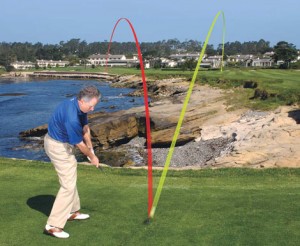 The goal for every golf shot is to reach a target. To do this you must apply the clubface to the ball in a way that creates the ball flight you intend. Attention on applying the clubface to the ball creates the swing and not vise-versa.
The goal for every golf shot is to reach a target. To do this you must apply the clubface to the ball in a way that creates the ball flight you intend. Attention on applying the clubface to the ball creates the swing and not vise-versa.
Your golf swing is dynamic and whole.
There is not one physical piece or part that makes it all work to create the desired outcome of proper club mechanics that produce the ball flight intended. All the parts work together to deliver the clubface to the ball. Your body is like a machine with many moving parts that must work in harmonious order; it all needs a good manager so that everything works together and at the right time.
I suggest that your brain is that manager. More specifically; your brain is a task manager.
Just think about how you get through daily life. You “shower”, “shave”, “dress”, “drive”, “eat”, “drink”, “walk”, “talk”, “stand”, “sit”, “hammer”, “rake”, “open”, “close”, etc. All of these are tasks. All you need is the intent to do the task and your brain manages your body to get the task done. Brilliant! So why would you treat a golf shot any differently?
For golf shots, the task is applying the clubface to the ball and the task process begins with “ball to target” imagery. This task orientation is the glue that combines all the swing ‘parts’ into one fluid motion that produces desired results. Once you have imagined “ball to target”, WHAT you are doing with the clubface to the ball is the primary task. The golf swing you produce will be an effect, not a cause. Misunderstanding this process is why sometimes golfers ask “What did I do right?” when they hit a great shot.
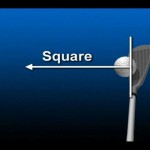 In many instances, a golfer’s intent is very simple, like “just hit it”, “ball then divot” or “keep the face square” and this task orientation orchestrates the body’s swing mechanics to deliver the goods. Sometimes golfers aren’t even that conscious of the task, they just have a fleeting glimpse or image of what they want to happen with the ball and automatically execute the shot without getting in their way consciously. That’s why they don’t know how they did it; they
In many instances, a golfer’s intent is very simple, like “just hit it”, “ball then divot” or “keep the face square” and this task orientation orchestrates the body’s swing mechanics to deliver the goods. Sometimes golfers aren’t even that conscious of the task, they just have a fleeting glimpse or image of what they want to happen with the ball and automatically execute the shot without getting in their way consciously. That’s why they don’t know how they did it; they 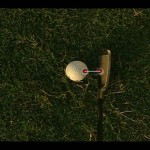 did the whole thing of “ball to target” and how is of little concern to the task oriented mind.
did the whole thing of “ball to target” and how is of little concern to the task oriented mind.
With intent only on the strike, spawned from the image of “ball to target”, great shots happen. And, those shots are usually great because that’s all the ball reacts to – the strike!
Here is your formula for success
Ball Flight is created by Club Mechanics that inform Swing Mechanics
Note: I often hear golfers say “I get it, but all I want is a swing that will hit the ball straight”. This comment usually stems from a false concept that if they “do the right swing” they will “hit the right shot”. My intent with this article is that you understand once and for all that you are in control of every shot you hit because you are in control of where you focus your attention. The reality is “if you hit the right shot, then the club moved the correct way, so you will have done the right swing”.
That’s right… Ball Flight is created by Club Mechanics that inform Swing Mechanics.
You can begin to apply these concepts during a practice session by simply playing with the clubface through impact. Focus on delivering a square clubface through impact for a few shots, then focus on delivering an open clubface for a few shots, then a closed clubface for a few shots. See what happens when you put your attention on your intention of what you are doing with the clubface through impact. I believe you will sense different swing mechanics for each variation. This little exercise may reveal that you can hit any shot you want when your attention is focused on a clear intent for What the clubface is doing through impact and not on How to swing.
Instead of HOPING for an intended shot with your attention on your swing, INTEND the shot with your attention on the club.
I invite you to give it a go and let me know what your experience reveals!

